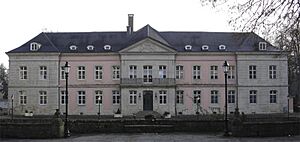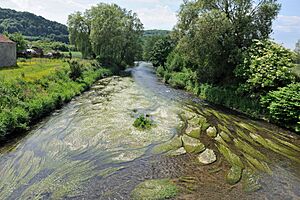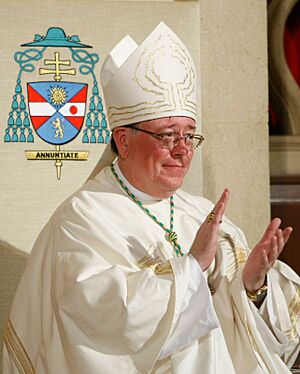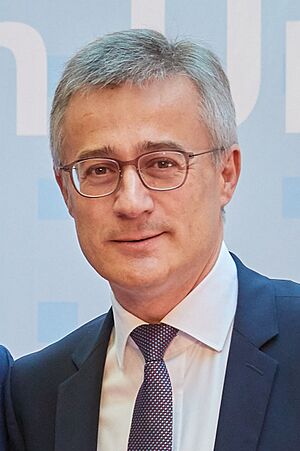Differdange facts for kids
Quick facts for kids
Differdange
|
|||
|---|---|---|---|
|
Commune
|
|||
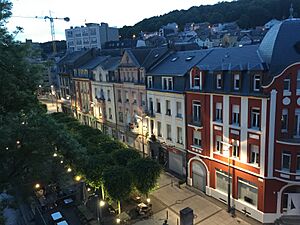
City center of Differdange
|
|||
|
|||
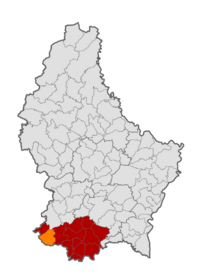
Map of Luxembourg with Differdange highlighted in orange, and the canton in dark red
|
|||
| Country | |||
| Canton | Esch-sur-Alzette | ||
| Area rank | ? of 100 | ||
| Highest elevation | 427 m (1,401 ft) | ||
| • Rank | 30th of 100 | ||
| Lowest elevation | 277 m (909 ft) | ||
| • Rank | 79th of 100 | ||
| Population
(1 January 2019)
|
|||
| • Total | 26,796 | ||
| • Rank | 3rd of 100 | ||
| • Density rank | 99th of 100 | ||
| Time zone | UTC+1 (CET) | ||
| • Summer (DST) | UTC+2 (CEST) | ||
| LAU 2 | LU0000202 | ||
| Website | differdange.lu | ||
Differdange is a lively town in southwestern Luxembourg. It is about 27 kilometers (17 miles) west of the country's capital, Luxembourg City. The town is close to the borders of Belgium and France.
Differdange is the third-largest city in Luxembourg, with a population of about 29,500 people. It is the main town in its area, which also includes smaller towns like Lasauvage, Niederkorn, Fousbann, and Oberkorn.
This town has a strong industrial past. It was once a major center for steel production in Luxembourg. Even today, Differdange is an important industrial hub. ArcelorMittal, the world's largest steel company, still has a steel plant here.
You can find some cool landmarks in Differdange. There's the Maison de Soins de Differdange, which used to be an old Cistercian abbey built in 1235. There's also the Differdange Castle, built in 1577. This castle is now used by Miami University for its European campus, called the Miami University Dolibois European Center.
Differdange is also home to the football team FC Differdange 03.
Contents
Towns and Villages in Differdange
The commune of Differdange includes several smaller towns and villages.
- Differdange (the main town)
- Lasauvage
- Niederkorn
- Oberkorn
- Fousbann
History of Differdange
The Cistercian Abbey
In 1235, a man named Alexandre de Soleuvre founded an abbey in Differdange. An abbey is a building where monks or nuns live and pray. This abbey was given to the Cistercian order, a group of monks and nuns.
At first, only noble women from Luxembourg could join the abbey. Later, women from nearby regions in France and Belgium also joined.
The abbey faced tough times. In 1552, French soldiers attacked and looted it. It suffered even more during a French invasion of Luxembourg in 1684.
The last leader of the convent, Marie-Madeleine de Gourcy, served until 1796. After that, the Cistercian order was officially ended. The abbey building was sold in 1797. In 1929, the town of Differdange bought it. Later, in 1981, the government of Luxembourg bought it and turned it into a hospital and health center.
The Renaissance Castle

The Differdange Castle is one of the few buildings left from the Renaissance period in the area. We don't know exactly when it was built because old records are missing. However, a knight named Wilhelm de Differdange was mentioned in documents from 1310.
The castle is thought to be one of the first castles in Luxembourg built completely in the Renaissance style. It was designed to be both a home and a strong defense. The family who owned the castle died out around 1400.
In 1552, a big fire damaged the castle. It was later repaired and lived in by Anna of Isenburg. In 1794, during the French Revolutionary Army's actions, the city of Differdange was attacked and burned.
The Iron City: Steel Industry
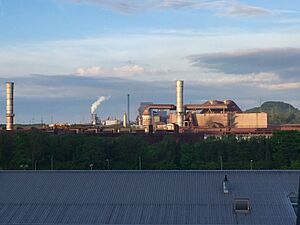
Starting in 1830, Luxembourg's steel industry began to grow from small workshops to large factories. In 1896, two large furnaces were built in Differdange. They were part of a company called "Société Anonyme des Hauts-Fourneaux de Differdange."
Later, eight more furnaces were built. These furnaces helped produce special steel beams that were famous at the time as "Differdinger" beams.
On August 4, 1907, Differdange officially became a town. This was made possible by William IV of Luxembourg.
The 20th century was a time of huge growth for the steel industry. Differdange's population grew from less than 4,000 people in 1890 to almost 18,000 by 1930.
In 1967, the Differdange steel company joined with other steel companies from Belgium and France. They formed ARBED, which became Luxembourg's biggest steel company. ARBED had many factories in Differdange. Today, the steel plant is part of ArcelorMittal.
Geography of Differdange
Differdange is located on a flat area near the Chiers river. The Chiers river is a branch of the Meuse river, and it starts in the Oberkorn area of Differdange.
The town of Differdange is about 293 meters (961 feet) above sea level. The highest point in the whole area is 427.1 meters (1,401 feet) high, at a place called Koufeld.
The total area of Differdange is about 2,215 hectares (about 8.5 square miles). Its land borders France, specifically the department of Meurme-et-Moselle.
Transportation
Differdange has several train stations that connect it to other places:
- Differdange railway station
- Oberkorn railway station
- Niederkorn railway station
Population Growth
Famous People from Differdange
Many interesting people have come from Differdange:
- Émile Krieps (1920–1998), a leader in the resistance during wartime, a soldier, and a politician.
- Jean Portante (born 1950), a writer of books, stories, plays, and poems. He lives in Paris.
- Josiane Kartheiser (born 1950), a journalist and writer.
- Nico Helminger (born 1953), an author who writes poetry, novels, and plays.
- Georges Hausemer (1957–2018), a writer of short stories, travel books, and non-fiction.
- Jean-Claude Hollerich S.J. (born 1958), who became the archbishop of the Roman Catholic Archdiocese of Luxembourg in 2011.
Sports Stars
Differdange has also produced many talented athletes:
- Michael Maurer (1904–??), a boxer who competed in the 1924 Summer Olympics.
- Fernand Ciatti (1912–1989), a boxer who competed at the 1936 Summer Olympics.
- Paul Anen (1918–1978), a fencer who competed in the 1948 and 1952 Summer Olympics.
- Jean-Fernand Leischen (1919–2017), a fencer who competed in three Summer Olympics.
- Josy Stoffel (born 1928), a gymnast who competed in 5 Olympic Games from 1948 to 1964.
- Rudy Kugeler (born 1928), a fencer who competed in the team épée event at the 1960 Summer Olympics.
- Fernand Backes (born 1930), a boxer who competed at the 1952 Summer Olympics.
- François Konter (1934–2018), a footballer who played 77 games for the national team.
- Roger Menghi (born 1935), a fencer who competed in the individual épée event at the 1976 Summer Olympics.
- Roby Hentges (born 1940), a former cyclist who competed in the individual road race at the 1960 Summer Olympics.
- Alain Anen (born 1950), a fencer who competed in the individual and team épée events at the 1972 Summer Olympics.
- Fiona Steil-Antoni (born 1989), a chess player from Luxembourg.
Twin Towns
Differdange has "twin town" relationships with several cities around the world. This means they share cultural and educational links.
 Ahlen, Germany
Ahlen, Germany Chaves, Portugal
Chaves, Portugal Fiuminata, Italy
Fiuminata, Italy Longwy, France
Longwy, France Oxford, United States
Oxford, United States Waterloo, Belgium
Waterloo, Belgium
See also
 In Spanish: Differdange para niños
In Spanish: Differdange para niños




